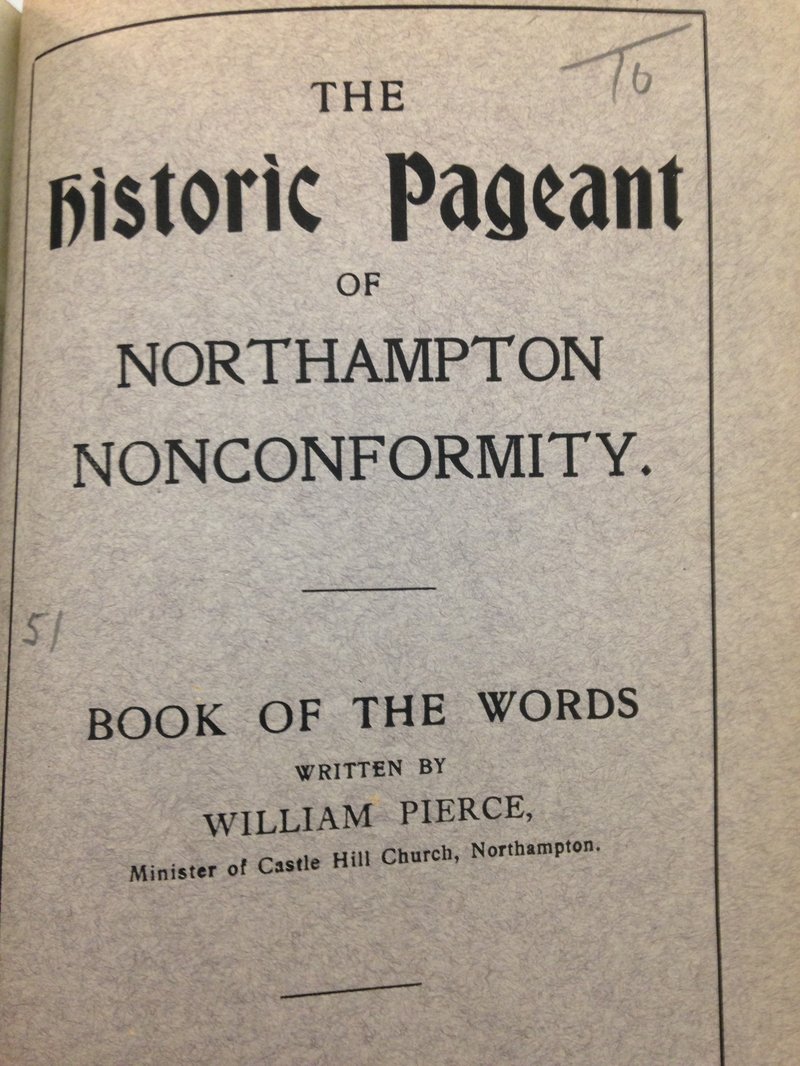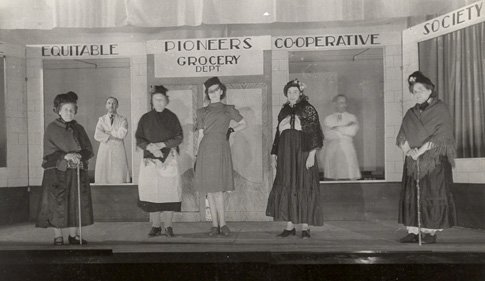Most humble men - by Tom Davis
Tom Davis is an undergraduate historian at the University of Exeter, Penryn Campus who is currently working on our Pageants project. Here, he compares two Pageants, the Historic Pageant of Northampton Nonconformity (1910), written by William Pierce and Co-operative Century. A Pageant of the People (1944), written by the prolific Pageant Master Lawrence du Garde Peach for the centenary of the Co-operative movement in Britain. Tom argues that there are significant overlaps between how the two movements presented their history through their presentations of the role of the common man in history.
Whether or not you agree with the religious
and political views of non-conformity or the Co-operative movement, it is
difficult not to find the two pageant texts I am studying charming in their
humility, or at least a refreshing change from the pomp and ceremony of many
historical pageants. The two pageants, ‘The Historic Pageant of Northampton
Nonconformity’ (1910) by William Pierce and ‘Co-operative Century: A Pageant of
the People’ (1944) by Lawrence Peach du Garde, are humble in purpose and care
not for the grandeur of monarchs and ancient heroes. For they truly are, as du
Garde proclaims, ‘pageants of the people’, focusing on ‘humble’ workers successfully
setting up their own peaceful community co-operative as a mechanism of social
change, amongst the violence and unrest of Revolutionary America, France and
Britain when gripped by Chartist and Anti-Corn Law discontents. For this, these
‘humble’ (a frequently-used word) men are celebrated as being true pioneers of
co-operatives, which have had much success and growth around the Britain, and
indeed the world.

Above: The Historic Pageant of Northampton Non-conformity (1910) by William Pierce
Pierce, a prolific writer a documenter of non-conformist history, takes a different, but no less proudly humble take: religion. We are taken through a journey through time contained within three epochs, starting first with news of the defeat of the Spanish Armada in 1588. The first, and in my opinion most poignant epoch, starts in a home of a book binder ready to sell the heretical and illegal documents of John Penry. Penry was an associate of the notorious Martin Marplrelate, who published his infamous and religiously radical Tracts in 1588-9 attacking the status quo of the Church of England. The Bishops come looking for this, most humble, man and he was hanged. He became a martyr for the non-conformist cause, and, much like his co-operative successors, is celebrated in this pageant as a brave pioneer of liberty and social change.
The two pageants talk of topics and issues that are subtly similar. Both praise a brave questioning and fight against a seemingly unjust status quo. Whether it be a Bishop’s noose; a shopkeeper holding a town to ransom through credit; a strange meeting between George Washington and King George III; or the secret meetings of ejected reformist priests from the church to establish a sanctum on Northampton’s Castle Hill, the themes are very much the same.
The pageants are indicative of how, at least in the first half of the century, these social movements viewed their history. There was, undoubtedly, an element of pride in these characters, who in themselves embody the movement’s undeterred love and worship of God (or the brotherhood of Man) throughout all adversity, but also an element of an internal need to address their past identity; their past, blotched with religious oppression and economic adversity, overcome and fought by these humble figures, some martyrs. The authors penned these texts with immense pride, and irrespective of political or religious beliefs this sense of identity must be respected.
There is a tendency among the vast majority
of the public (and until very recently myself included) to ignore or overlook
the massive efforts non-conformists went through to achieve their own liberty –
including those featured in the pageants. We seem all too willing to shop at
the Co-op for convenient groceries, but how many of us realise and appreciate
the difficulties the pioneers and radicals had to go through to create the
brand for those shops? When we walk past a Methodist church or Quaker meeting
hall, how many of us appreciate the secrecy and danger the early members had to
go through for those churches not only to be built, but for congregations to
even allowed to practice their forms of worship. Shamefully, all too few of us
recognise this, and through most part this is because we simply don’t know.

Above: The Bletchco Players performing the Co-operative Century: A Pageant of the People in 1944
It is therefore clear that pageants are much more vital than one might first assume. They keep the memories and struggles of the past alive for modern members, but are a vital tool in teaching those of us unaware of the persecutions suffered. This pageantry project has so far taught me at least this one important lesson, that we take many liberties and rights for granted today. Pageants offer a way to immerse ourselves and appreciate the struggles and persecutions some had to suffer in the past. Maybe we should all take the time to read, or at least try to better understand historical pageants and the ‘humble’ messages they can provide us.
Tom Davis
